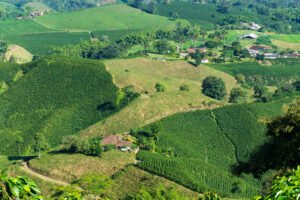The 3 Main Coffee Growing Regions in Colombia
Colombia is long known as having the best coffee in the world. This is due to various factors, such as the type of coffee that they grow. Colombia is one of the few coffee-producing countries that grows solely Arabica beans, which is the preferred type of coffee by many. However, their carefully crafted process and ideal growing conditions also play a role in their success.
Colombian coffee is famous for being a medium-bodied coffee with a rich taste, but its underlying flavors can vary. Though it’s often recognized by its citrus-like acidity, fruity undertones, and notes of chocolate, its flavor highly depends on the region that it’s grown. This is due to different soil conditions, microclimates, and altitude. In fact, it’s not unheard of for two neighboring coffee farms to have unique flavors. That said, each region in Colombia can be identified by the characteristics of their coffee, even if there are some variations.
Colombia Coffee Growing Regions
There are many distinct coffee growing regions in Colombia, each with their own traditions and processes. Today, we’re going to break them down into 3 main areas: north, central north and central south, and south.
North
The north of Colombia has the popular coffee-producing sub-regions of Santander, Norte de Santander, La Guajira, Magdalena, and Cesar. The coffee is harvested when the wet season ends, which is typically in October or November. The coffee in the northern region is known for having less acidity and more body. It’s also known for having nutty and chocolate notes.
Central North and Central South
The big producers in this region are Antioquia, Caldas, Chocó, Risaralda, Quindío, Cundinamarca, and North of Tolima. The famous Coffee Triangle, which consists of Caldas, Risaralda and Quindio, is famous for producing a majority of Colombian coffee, and it’s become an attraction for many people around the world. Another department worth highlighting is Antioquia, which is the second largest coffee producing region in Colombia, with Tolima being the third.
Since the central north and central south region covers a large area, the flavors in the coffee may vary. This is even more true due to the fact that there’s two harvest seasons. In general, though, the flavor is described as herbal and fruity with a medium-high body. Many people enjoy the coffee from this region because of its slightly sweeter flavor.
South
The main sub-regions in the south are Cauca, Huila and Nariño. Since this region is closer to the equator, the coffee is grown at higher altitudes. This region is especially recognized for its quality. In fact, Huila won the Denomination of Origin in 2013; this means it was awarded for its quality and characteristics that are a result of the geographical location. The coffee in this region is known for its strong hints of acidity and citrus flavors.
Why Altitude Plays a Big Role in the Flavor
As displayed in the image, the flavor of coffee beans relies heavily on the altitude. At higher altitudes, the coffee plant is exposed to harsher conditions and lack of oxygen. Though this may sound unfavorable, it actually works to its advantage. The longer maturation process allows the beans more time to fully develop its flavors. Thanks to the mountain ranges that cross Colombia, the coffee farms are usually located between 1,200 and 1,800 meters above sea level. This helps contribute to the complex and rich flavor that Colombian coffee is known for.
The coffee-growing regions that were identified in this article are described by the characteristics of their coffee. As we mentioned, though, there can be distinct flavors even between neighboring farms. This is because the different altitudes can affect the climate, soil, and water – all of which affect the flavor of the coffee beans. This, along with different processes, is the reason why there is so much variation in flavor in Colombia, as well as other parts of the world.
Experiencing a Real Coffee Farm

There’s no better way to indulge in Colombian culture than by understanding the delicate coffee processing methods that are used. When you combine the fact that Medellin is a popular tourist destination with the knowledge that Antioquia is the second largest producer of coffee in Colombia, it’s no surprise that many people are interested in learning more about traditional coffee production.
Coffee tours provide valuable insight into the importance of coffee throughout Colombia. Tourists and locals alike can meet the families who make it possible and try the flavors from that specific coffee farm
Pingback: How to Choose a Good Colombian Coffee? - Local tours medellin
Pingback: Where Does Colombian Coffee Come From? – A Timeline - Local tours medellin